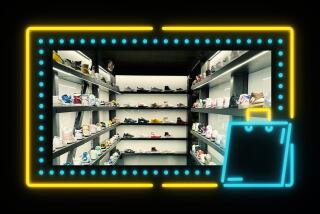African Traders
Viki Dyanâs goal was to combine all her loves--different cultures, unusual textiles, travel, design--into some kind of business that would support her.
She succeeded.
âSomehow Iâve managed to do that with my new African-inspired clothing and jewelry designs,â says Dyan, who divides her time between Costa Mesa and Santa Rosa, Calif.
Dyan had always wanted to be a designer. In the â80s, she successfully created one-of-a-kind hand-woven knits that sold at several upscale department stores. âAs time went on, it got harder and harder to make a living doing that. Hand-woven-looking fabrics were being produced cheaply abroad, and the economy changed,â she says. âPeople didnât have $1,000 to spend on an outfit.â
Burned out from overwork, she took a vacation to Tobago in the Caribbean in the early â90s. She liked the island so much that she packed up her sewing machine and opened a shop there, selling her fashions and jewelry designs.
âIn the meantime, my sister opened a store on Balboa Peninsula in Newport Beach, and I was flying back and forth and helping her part-time.â
It was through her sister that Dyan met B.M.W. Kiro-Kiro, who sold African art.
While Dyan was changing her life, so was Kiro.
Growing up in Zaire and Rwanda, he developed a love of African art that led to him owning three art galleries in that region. But during civil unrest in 1990, one gallery was burned, one blown up and one overtaken.
Six years ago, Kiro was granted asylum in the United States. He moved to Costa Mesa to be near the Orange County swap meet, where he sold his African goods. He met Dyan in 1993.
One year ago, Kiro and Dyan took a two-month trip to Africa (the first time heâd been back). They visited Uganda, Kenya and Tanzania. âIt was like a giant reunion for him,â remembers Dyan. âWe gave away or traded all our clothes and brought back fabrics and beads.â
Those fabrics and beads became the cornerstone of a new business. Dyan now designs menâs and womenâs shirts, vests and jackets from batiks made in Nigeria, mud cloth from Mali and prints from Benin, the Ivory Coast and Senegal. They hope to return twice a year.
The yellows, reds, blues and black colors of the fabrics are from natural dyes that come from trees, leaves, bark, raffia and resin.
In Africa, all the handmade cloth is used in ceremonies, and many are worn only by kings or queens.
âThe fabrics are also used in communication,â Kiro says. âFor example, one design is about good luck and having good wishes. Another has to do with patching up quarrels between two friends.â
Dyan prewashes the fabrics in cold water to clean and soften them, but she recommends dry cleaning so the natural colors donât fade.
She also creates jewelry from amber and Ethiopian silver and buttons of animal bone. âWhen I was in Africa I met a man who works in bone, so I designed buttons that he makes for me,â she says. âNow most of my clothes have handmade bone buttons.â
Her designs are available at the Bowers Museum gift shop in Santa Ana; Townsends in Laguna Beach; and Kiroâs shop, African Corner, in the Westminster Mall.
âI got this shop because Viki read in the paper that they had empty spaces in the mall,â Kiro says. âLuckily, I got one of those spaces.â
African Corner also sells art objects, masks and sculptures as well as photographs of African wildlife by Newport Beach photographer David Kluver.
Two of Kiroâs children, Dalila, 22, and Tillo, 20, work with him in the shop. âI really appreciate being here in America, which is a great free country.â


